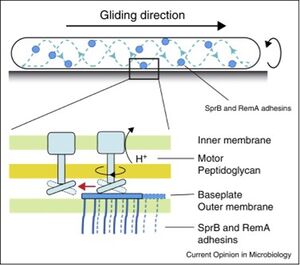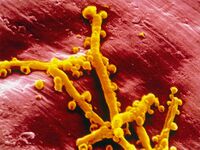Flavobacterium

| |
| Kingdom: | Bacteria |
|---|---|
| Subkingdom: | Negibacteria |
| Phylum: | Bacteriodetes |
| Class: | Flavobacteriia |
| Order: | Flavobacteriales |
| Family: | Flavobacteriaceae |
| Genus: | Flavobacterium |
| Source: Integrated Taxonomic Information System | |
Flavobacterium is a genus of widely distributed, gram-negative bacteria characterized by their rod-like body shape which is capped by either a rounded or tapered end. Known as highly “social” bacteria, flavobacterium colonies tend to form complex biofilms which can also produce a basal form of iridescence. A genus-wide metropolitan distribution of flavobacterium is exemplified by their heavy presence in soil, water, raw meats, unpasteurized dairy products, sewage, and most hospital or clinical environments. Most well known for their diverse pathogenic qualities, flavobacteria are well documented antagonist in fish population collapse, neonatal meningitis, and a host of animal respiratory illnesses.
Morphology
Members of flavobacterium range in size from 2 - 5 micrometers in length, and 0.3 - 0.5 micrometers in width. Though rather simple regarding initial morphological character, flavobacterium motility and colonial pattern play critical roles in defining surface characteristics of individuals and their respective species classification.

Motility
Flavobacterium lack traditional movement through the use cilia or flagella, instead relying on a mechanistic process termed gliding. Gliding is an active, energy needy process that results in the translocation of cells over a surface without the use of specialized appendages, like that of flagella and cilia. Flavobacterium species can utilize one of two means of gliding; one uses semi-surface Type IV pili, while the other uses cell surface, cross-linking peptidoglycan. Gliding motility via the use of Type IV pili requires a contractile response of polar pili to create a “twitching” motion which moves the cell forward. Polar pili protrude from either end of the cell to adhere to their surface, where they then create an electrical charge using ambient ions to contract and “pull” the cell in a desired direction. Peptidoglycan gliding utilizes cell surface, interlinked peptidoglycan “meshes” which adhere to the surface to create a track which the cells “rolls” along in a similar way to that of a tank tread. Both forms of gliding follow the long axis of the cell creating rather linear patterns of movement.

Colonial Growth
The high energy cost and limited range of movement associated with flavobacterium gliding results in the formation of compact colonies characterized by thin spreading edges and complex, highly structured centers. The interwoven nature of colonies helps to create 2D structures called photonic crystals, which then interact with light to produce a wide variety of iridescence. Colony iridescence is influenced by environmental nutrition, salinity, humidity, and temperature, as well as the physical geometry of its structure and angular perception of such structure by its observer.
Ecology
Environment
Members of flavobacterium are found both aquatically and terrestrially worldwide. Strictly aquatic species typically reside in marine environments near social fish; this allows for the increased transference of pathogenic flavobacteria whom tend to form detrimental relationships which drastically increase fish mortality rates. Terrestrially, flavobacterium can be found in variable soil qualities from the tropics to the tundra. Aside from the ambient dispersal of flavobacterium among soils, some species have coevolved with animals, often appearing as natural flora within the microbiomes of said animals. As a natural member of animal flora, several flavobacterium species can be found in raw meats, unpasteurized dairy products, and waste products. These contaminated animal products are major contributors to disease, further increasing distribution potential of the highly pathogenic flavobacterium genus.

Human Pathogenicity
While unlikely to encounter pathogenic flavobacterium on your own, consumption of contaminated meats or other animal products can result in bacteremia, a general term for bloodstream bacterial infections. A weakened immune system, or strong enough bacterium in your bloodstream, can result in septicemia, commonly referred to as sepsis, which is associated with prolonged infections of bacteremia. Additionally, pneumonia and other respiratory illnesses can occur due to flavobacterium colonial growth within the lungs or respiratory tract of humans and animals alike.
Flavobacterium species are also commonly found in hospitals and similar clinical environments due to widespread resistances to antibiotics such as penicillin and polymyxin. The most prominent species is Flavobacterium meningosepticum, responsible for meningitis in newborn infants and immunocompromised adults.
References
Chong, R. S.-M. 2022. Chapter 28 - Flavobacteriosis. Pages 367–377 in F. S. B. Kibenge, B. Baldisserotto, and R. S.-M. Chong, editors. Aquaculture Pathophysiology. Academic Press.
Flavobacterium Meningo- Septicum Bacteria by Cnri/science Photo Library. (n.d.). . https://sciencephotogallery.com/featured/flavobacterium-meningo-septicum-bacteria-cnriscience-photo-library.html.
García-López, M.-L., J.-Á. Santos, and A. Otero. 1999. FLAVOBACTERIUM. Pages 820–826 in R. K. Robinson, editor. Encyclopedia of Food Microbiology. Elsevier, Oxford.
Groutars, E. G., C. C. Risseeuw, C. Ingham, R. Hamidjaja, W. S. Elkhuizen, S. C. Pont, and E. Karana. 2022. Flavorium: An Exploration of Flavobacteria’s Living Aesthetics for Living Color Interfaces. Pages 1–19 CHI Conference on Human Factors in Computing Systems. ACM, New Orleans LA USA.
Inzana, T. J. 1990. 14 - Miscellaneous Glucose-Nonfermenting Gram-Negative Bacteria. Pages 165–176 in G. R. Carter and J. R. Cole, editors. Diagnostic Procedure in Veterinary Bacteriology and Mycology (Fifth Edition). Academic Press, San Diego.
ITIS - Report: Flavobacterium. (n.d.). . https://www.itis.gov/servlet/SingleRpt/SingleRpt?search_topic=TSN&search_value=174#null.
Li, S., J. Chai, C. Knupp, P. Nicolas, D. Wang, Y. Cao, F. Deng, F. Chen, T. Lu, and T. P. Loch. 2021. Phenotypic and Genetic Characterization of Flavobacterium psychrophilum Recovered from Diseased Salmonids in China. Microbiology Spectrum 9:e00330-21.
McBride, M. J. 2001. Bacterial Gliding Motility: Multiple Mechanisms for Cell Movement over Surfaces. Annual Review of Microbiology 55:49–75.
McBride, M. J., and D. Nakane. 2015. Flavobacterium gliding motility and the type IX secretion system. Current Opinion in Microbiology 28:72–77.
Zaheen, Z., A. F. War, S. Ali, A. M. Yatoo, Md. N. Ali, S. B. Ahmad, M. U. Rehman, and B. A. Paray. 2022. Chapter 7 - Common bacterial infections affecting freshwater fish fauna and impact of pollution and water quality characteristics on bacterial pathogenicity. Pages 133–154 in G. H. Dar, R. A. Bhat, H. Qadri, K. M. Al-Ghamdy, and K. R. Hakeem, editors. Bacterial Fish Diseases. Academic Press.